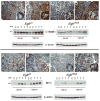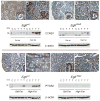Epidermal growth factor receptor is required for colonic tumor promotion by dietary fat in the azoxymethane/dextran sulfate sodium model: roles of transforming growth factor-{alpha} and PTGS2
- PMID: 19903783
- PMCID: PMC2785126
- DOI: 10.1158/1078-0432.CCR-09-1678
Epidermal growth factor receptor is required for colonic tumor promotion by dietary fat in the azoxymethane/dextran sulfate sodium model: roles of transforming growth factor-{alpha} and PTGS2
Abstract
Purpose: Colon cancer is a major cause of cancer deaths. Dietary factors contribute substantially to the risk of this malignancy. Western-style diets promote development of azoxymethane-induced colon cancer. Although we showed that epidermal growth factor receptors (EGFR) controlled azoxymethane tumorigenesis in standard fat conditions, the role of EGFR in tumor promotion by high dietary fat has not been examined.
Experimental design: A/J x C57BL6/J mice with wild-type Egfr (Egfr(wt)) or loss-of-function waved-2 Egfr (Egfr(wa2)) received azoxymethane followed by standard (5% fat) or western-style (20% fat) diet. As F(1) mice were resistant to azoxymethane, we treated mice with azoxymethane followed by one cycle of inflammation-inducing dextran sulfate sodium to induce tumorigenesis. Mice were sacrificed 12 weeks after dextran sulfate sodium. Tumors were graded for histology and assessed for EGFR ligands and proto-oncogenes by immunostaining, Western blotting, and real-time PCR.
Results: Egfr(wt) mice gained significantly more weight and had exaggerated insulin resistance compared with Egfr(wa2) mice on high-fat diet. Dietary fat promoted tumor incidence (71.2% versus 36.7%; P < 0.05) and cancer incidence (43.9% versus 16.7%; P < 0.05) only in Egfr(wt) mice. The lipid-rich diet also significantly increased tumor and cancer multiplicity only in Egfr(wt) mice. In tumors, dietary fat and Egfr(wt) upregulated transforming growth factor-alpha, amphiregulin, CTNNB1, MYC, and CCND1, whereas PTGS2 was only increased in Egfr(wt) mice and further upregulated by dietary fat. Notably, dietary fat increased transforming growth factor-alpha in normal colon.
Conclusions: EGFR is required for dietary fat-induced weight gain and tumor promotion. EGFR-dependent increases in receptor ligands and PTGS2 likely drive diet-related tumor promotion.
Figures



Similar articles
-
EGFR signals downregulate tumor suppressors miR-143 and miR-145 in Western diet-promoted murine colon cancer: role of G1 regulators.Mol Cancer Res. 2011 Jul;9(7):960-75. doi: 10.1158/1541-7786.MCR-10-0531. Epub 2011 Jun 8. Mol Cancer Res. 2011. PMID: 21653642 Free PMC article.
-
The renin-angiotensin system mediates EGF receptor-vitamin d receptor cross-talk in colitis-associated colon cancer.Clin Cancer Res. 2014 Nov 15;20(22):5848-5859. doi: 10.1158/1078-0432.CCR-14-0209. Epub 2014 Sep 11. Clin Cancer Res. 2014. PMID: 25212605 Free PMC article.
-
Daily Intake of High-Fat Diet with Lysophosphatidic Acid-Rich Soybean Phospholipids Augments Colon Tumorigenesis in Kyoto Apc Delta Rats.Dig Dis Sci. 2017 Mar;62(3):669-677. doi: 10.1007/s10620-016-4434-5. Epub 2017 Jan 3. Dig Dis Sci. 2017. PMID: 28050783
-
Dietary fat and colon cancer: modulating effect of types and amount of dietary fat on ras-p21 function during promotion and progression stages of colon cancer.Cancer Res. 1997 Jan 15;57(2):253-8. Cancer Res. 1997. PMID: 9000564
-
Epidermal growth factor receptor signaling is required for microadenoma formation in the mouse azoxymethane model of colonic carcinogenesis.Cancer Res. 2007 Jan 15;67(2):827-35. doi: 10.1158/0008-5472.CAN-05-3343. Cancer Res. 2007. PMID: 17234795 Free PMC article.
Cited by
-
The Role of Aspirin, Vitamin D, Exercise, Diet, Statins, and Metformin in the Prevention and Treatment of Colorectal Cancer.Curr Treat Options Oncol. 2015 Sep;16(9):43. doi: 10.1007/s11864-015-0359-z. Curr Treat Options Oncol. 2015. PMID: 26187794 Review.
-
PDGFA-associated protein 1 is a novel target of c-Myc and contributes to colorectal cancer initiation and progression.Cancer Commun (Lond). 2022 Aug;42(8):750-767. doi: 10.1002/cac2.12322. Epub 2022 Jun 18. Cancer Commun (Lond). 2022. PMID: 35716012 Free PMC article.
-
Upregulation of polycistronic microRNA-143 and microRNA-145 in colonocytes suppresses colitis and inflammation-associated colon cancer.Epigenetics. 2021 Dec;16(12):1317-1334. doi: 10.1080/15592294.2020.1863117. Epub 2020 Dec 28. Epigenetics. 2021. PMID: 33356812 Free PMC article.
-
A novel mouse model of sporadic colon cancer induced by combination of conditional Apc genes and chemical carcinogen in the absence of Cre recombinase.Carcinogenesis. 2019 Nov 25;40(11):1376-1386. doi: 10.1093/carcin/bgz050. Carcinogenesis. 2019. PMID: 30859181 Free PMC article.
-
Divergent effects of muscarinic receptor subtype gene ablation on murine colon tumorigenesis reveals association of M3R and zinc finger protein 277 expression in colon neoplasia.Mol Cancer. 2014 Apr 3;13:77. doi: 10.1186/1476-4598-13-77. Mol Cancer. 2014. PMID: 24694019 Free PMC article.
References
-
- Rim SH, Seeff L, Ahmed F, King JB, Coughlin SS. Colorectal cancer incidence in the United States, 1999-2004 : an updated analysis of data from the National Program of Cancer Registries and the Surveillance, Epidemiology, and End Results Program. Cancer. 2009 - PubMed
-
- Lipkin M, Reddy B, Newmark H, Lamprecht SA. Dietary factors in human colorectal cancer. Annu Rev Nutr. 1999;19:545–86. - PubMed
-
- Parkin DM, Muir CS, Whelan SL. Cancer incidence in five continents. Lyon: International agency for research on cancer scientific publications; 1992.
-
- Haenszel W, Kurihara M. Studies of Japanese migrants. I. Mortality from cancer and other diseases among Japanese in the United States. J Natl Cancer Inst. 1968;40:43–68. - PubMed
-
- Rao CV, Hirose Y, Indranie C, Reddy BS. Modulation of experimental colon tumorigenesis by types and amounts of dietary fatty acids. Cancer Res. 2001;61:1927–33. - PubMed
Publication types
MeSH terms
Substances
Grants and funding
LinkOut - more resources
Full Text Sources
Other Literature Sources
Research Materials
Miscellaneous

